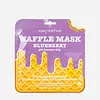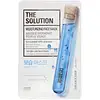What's inside
What's inside
 Key Ingredients
Key Ingredients

 Benefits
Benefits

 Concerns
Concerns

 Ingredients Side-by-side
Ingredients Side-by-side

Water
Skin ConditioningDipropylene Glycol
HumectantMethylpropanediol
SolventGlycerin
Humectant1,2-Hexanediol
Skin ConditioningHydroxyacetophenone
AntioxidantArginine
MaskingAcrylates/C10-30 Alkyl Acrylate Crosspolymer
Emulsion StabilisingAmmonium Acryloyldimethyltaurate Crosspolymer
Emulsion StabilisingPolyglyceryl-10 Laurate
Skin ConditioningPolyglyceryl-10 Myristate
Skin ConditioningButylene Glycol
HumectantXanthan Gum
EmulsifyingSodium Phytate
Sodium Hyaluronate
HumectantVaccinium Angustifolium Fruit Extract
Skin ProtectingTocopheryl Acetate
AntioxidantParfum
MaskingT-Butyl Alcohol
PerfumingHydrolyzed Gardenia Florida Extract
AntioxidantMaltodextrin
AbsorbentSpirulina Maxima Extract
SmoothingPsidium Guajava Fruit Extract
AstringentPropylene Glycol
HumectantCucurbita Pepo Fruit Extract
Skin ConditioningCyclohexane
SolventGarcinia Mangostana Peel Extract
Skin ConditioningArtemisia Princeps Leaf Extract
Skin ConditioningWater, Dipropylene Glycol, Methylpropanediol, Glycerin, 1,2-Hexanediol, Hydroxyacetophenone, Arginine, Acrylates/C10-30 Alkyl Acrylate Crosspolymer, Ammonium Acryloyldimethyltaurate Crosspolymer, Polyglyceryl-10 Laurate, Polyglyceryl-10 Myristate, Butylene Glycol, Xanthan Gum, Sodium Phytate, Sodium Hyaluronate, Vaccinium Angustifolium Fruit Extract, Tocopheryl Acetate, Parfum, T-Butyl Alcohol, Hydrolyzed Gardenia Florida Extract, Maltodextrin, Spirulina Maxima Extract, Psidium Guajava Fruit Extract, Propylene Glycol, Cucurbita Pepo Fruit Extract, Cyclohexane, Garcinia Mangostana Peel Extract, Artemisia Princeps Leaf Extract
Water
Skin ConditioningPropanediol
SolventAlcohol Denat.
AntimicrobialPEG/PPG-17/6 Copolymer
SolventGlycerin
HumectantPanthenol
Skin ConditioningPaeonia Suffruticosa Root Extract
Skin ProtectingCeramide NP
Skin ConditioningSodium Hyaluronate
HumectantAllantoin
Skin ConditioningHydrogenated Lecithin
EmulsifyingHydroxyethylcellulose
Emulsion StabilisingCitrus Paradisi Fruit Extract
Skin ConditioningHydroxyethyl Acrylate/Sodium Acryloyldimethyl Taurate Copolymer
Emulsion StabilisingCarbomer
Emulsion StabilisingSodium Polyacrylate
AbsorbentCaprylic/Capric Triglyceride
MaskingEthylhexylglycerin
Skin ConditioningPEG-40 Hydrogenated Castor Oil
EmulsifyingPotassium Hydroxide
BufferingDisodium EDTA
Phenyl Trimethicone
Skin ConditioningDimethicone
EmollientParfum
MaskingWater, Propanediol, Alcohol Denat., PEG/PPG-17/6 Copolymer, Glycerin, Panthenol, Paeonia Suffruticosa Root Extract, Ceramide NP, Sodium Hyaluronate, Allantoin, Hydrogenated Lecithin, Hydroxyethylcellulose, Citrus Paradisi Fruit Extract, Hydroxyethyl Acrylate/Sodium Acryloyldimethyl Taurate Copolymer, Carbomer, Sodium Polyacrylate, Caprylic/Capric Triglyceride, Ethylhexylglycerin, PEG-40 Hydrogenated Castor Oil, Potassium Hydroxide, Disodium EDTA, Phenyl Trimethicone, Dimethicone, Parfum
 Reviews
Reviews

Ingredients Explained
These ingredients are found in both products.
Ingredients higher up in an ingredient list are typically present in a larger amount.
Glycerin is already naturally found in your skin. It helps moisturize and protect your skin.
A study from 2016 found glycerin to be more effective as a humectant than AHAs and hyaluronic acid.
As a humectant, it helps the skin stay hydrated by pulling moisture to your skin. The low molecular weight of glycerin allows it to pull moisture into the deeper layers of your skin.
Hydrated skin improves your skin barrier; Your skin barrier helps protect against irritants and bacteria.
Glycerin has also been found to have antimicrobial and antiviral properties. Due to these properties, glycerin is often used in wound and burn treatments.
In cosmetics, glycerin is usually derived from plants such as soybean or palm. However, it can also be sourced from animals, such as tallow or animal fat.
This ingredient is organic, colorless, odorless, and non-toxic.
Glycerin is the name for this ingredient in American English. British English uses Glycerol/Glycerine.
Learn more about GlycerinParfum is a catch-all term for an ingredient or more that is used to give a scent to products.
Also called "fragrance", this ingredient can be a blend of hundreds of chemicals or plant oils. This means every product with "fragrance" or "parfum" in the ingredients list is a different mixture.
For instance, Habanolide is a proprietary trade name for a specific aroma chemical. When used as a fragrance ingredient in cosmetics, most aroma chemicals fall under the broad labeling category of “FRAGRANCE” or “PARFUM” according to EU and US regulations.
The term 'parfum' or 'fragrance' is not regulated in many countries. In many cases, it is up to the brand to define this term.
For instance, many brands choose to label themselves as "fragrance-free" because they are not using synthetic fragrances. However, their products may still contain ingredients such as essential oils that are considered a fragrance by INCI standards.
One example is Calendula flower extract. Calendula is an essential oil that still imparts a scent or 'fragrance'.
Depending on the blend, the ingredients in the mixture can cause allergies and sensitivities on the skin. Some ingredients that are known EU allergens include linalool and citronellol.
Parfum can also be used to mask or cover an unpleasant scent.
The bottom line is: not all fragrances/parfum/ingredients are created equally. If you are worried about fragrances, we recommend taking a closer look at an ingredient. And of course, we always recommend speaking with a professional.
Learn more about ParfumSodium Hyaluronate is hyaluronic acid's salt form. It is commonly derived from the sodium salt of hyaluronic acid.
Like hyaluronic acid, it is great at holding water and acts as a humectant. This makes it a great skin hydrating ingredient.
Sodium Hyaluronate is naturally occurring in our bodies and is mostly found in eye fluid and joints.
These are some other common types of Hyaluronic Acid:
Learn more about Sodium HyaluronateWater. It's the most common cosmetic ingredient of all. You'll usually see it at the top of ingredient lists, meaning that it makes up the largest part of the product.
So why is it so popular? Water most often acts as a solvent - this means that it helps dissolve other ingredients into the formulation.
You'll also recognize water as that liquid we all need to stay alive. If you see this, drink a glass of water. Stay hydrated!
Learn more about Water